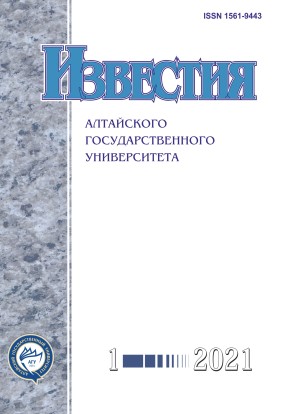Influence of Composition on the Evolution of Dislocation Substructure in the Low-Stability State Polycrystalline Cu-Al Alloys under Plastic Deformation
УДК 539.3
Abstract
New concepts of dislocation physics of plasticity and strength are considered using quantitative methods of transmission diffraction electron microscopy. New concepts of dislocation physics of plasticity and strength are considered using quantitative methods of transmission diffraction electron microscopy. The analysis of changes in the parameters of the dislocation substructure (DSS) is given on the example of alloys Cu-0.5 and 14 аt. % Al and the influence of these parameters on the change in the substructure of the material at a temperature T=293 K is considered. It is shown that at each stage of deformation, there are usually two substructures ("old" and "new"). The blurring of the transition from stage to stage is associated with the presence of weakly stable pre-transition structural-phase States at certain degrees of deformation of several types of substructures simultaneously, i.e., a weakly stable structural-phase state of the system. Against the background of the "old" substructure, a "new" one is born, which in the process of deformation becomes the main one, and then the "old" one, in the depths of which another substructure is formed. Experimental evidence of this regularity is obtained for FCC alloys. The presence of grain boundaries complicates the diagrams: a third substructure is formed near the grain boundaries, which corresponds to the following substructures (later) in the sequence of DSS transformations.
Downloads
Metrics
References
Панин В.Е., Лихачев В.А., Гриняев Ю.В. Структурные уровни деформации твердых тел. Новосибирск, 1985.
Физическая мезомеханика и компьютерное конструирование материалов / под ред. акад. В.Е. Панина. Новосибирск, 1995. Т. 1.
Панин В.Е., Гриняев Ю.В. Физическая мезомеханика — новая парадигма на стыке физики и механики деформируемого твердого тела // Физ. мезомех. 2003. Т. 6. № 4.
Конева Н.А., Козлов Э.В. Природа субструктурного упрочнения // Изв. вузов. Физика. 1982. № 8.
Конева Н.А., Козлов Э.В. Закономерности субструктурного упрочнения // Изв. вузов. Физика. 1991. № 3.
Ren C.X., Wang Q., Hou J.P. and et al. Exploring the strength and ductility improvement of Cu-Al alloys // Materials Science & Engineering. 2020. A786. 139441.
Chakravarty S., Sikdar K., Singh S.S., Roy D., Koch C.С. Grain size stabilization and strengthening of cryomilled nanostructured Cu 12 at% Al alloy // J. Alloys and Compounds. 2017. Vol. 716.
Зайнуллина Л.И., Александров И.В. Влияние ЭДУ на прочностные свойства сплавов системы Cu–Al, подвергнутых РКУП при криогенной температуре // Молодежный вестник УГАТУ. 2019. № 2 (21).
Конева Н.А., Тришкина Л.И., Черкасова Т.В., Козлов Э.В. Влияние температуры деформации и размера зерна на формирование субструктуры и величину вкладов геометрически необходимых и статистически запасенных дислокаций в среднюю плотность дислокаций в сплавах системы Cu-Al // Фундаментальные проблемы современного материаловедения. 2009. Т. 6. № 4.
Конева Н.А., Тришкина Л.И., Потекаев А.И., Козлов Э.В. Структурно-фазовые превращения в слабоустойчивых состояниях металлических систем при термосиловом воздействии. Томск, 2015.
Конева Н.А., Потекаев А.И., Тришкина Л.И., Черкасова Т.В., Клопотов А.А. Роль критических размеров зерен поликристаллов мезоуровня в ходе деформации в слабоустойчивом состоянии металлов и сплавов // Известия вузов. Физика. 2020. Т. 63. № 5.
Лякишев Н.П. Диаграммы состояния двойных металлических систем. М., 1996. Т. 1.
Барабаш О.М., Коваль Ю.Н. Структура и свойства металлов и сплавов. Киев, 1986.
Юм-Розери В., Рейнор Г. Структура металлов и их сплавов. М., 1959.
Марадудин А., Монтрелл Э., Вейс Дж. Динамическая теория кристаллической решетки в гармоническом приближении. М., 1965.
Izvestiya of Altai State University is a golden publisher, as we allow self-archiving, but most importantly we are fully transparent about your rights.
Authors may present and discuss their findings ahead of publication: at biological or scientific conferences, on preprint servers, in public databases, and in blogs, wikis, tweets, and other informal communication channels.
Izvestiya of Altai State University allows authors to deposit manuscripts (currently under review or those for intended submission to Izvestiya of Altai State University) in non-commercial, pre-print servers such as ArXiv.
Authors who publish with this journal agree to the following terms:
- Authors retain copyright and grant the journal right of first publication with the work simultaneously licensed under a Creative Commons Attribution License (CC BY 4.0) that allows others to share the work with an acknowledgement of the work's authorship and initial publication in this journal.
- Authors are able to enter into separate, additional contractual arrangements for the non-exclusive distribution of the journal's published version of the work (e.g., post it to an institutional repository or publish it in a book), with an acknowledgement of its initial publication in this journal.
- Authors are permitted and encouraged to post their work online (e.g., in institutional repositories or on their website) prior to and during the submission process, as it can lead to productive exchanges, as well as earlier and greater citation of published work (See The Effect of Open Access).








